
The Trinitarians, formally known as the Order of the Most Holy Trinity and of the Captives, is a mendicant order of the Catholic Church for men founded in Cerfroid, outside Paris, in the late 12th century. From the very outset, a special dedication to the mystery of the Holy Trinity has been a constitutive element of the order's life.

Peter Nolasco, O. de M. was a Catholic priest known for founding the Royal and Military Order of Our Lady of Mercy of the Redemption of the Captives with approval by Pope Gregory IX in 1230.
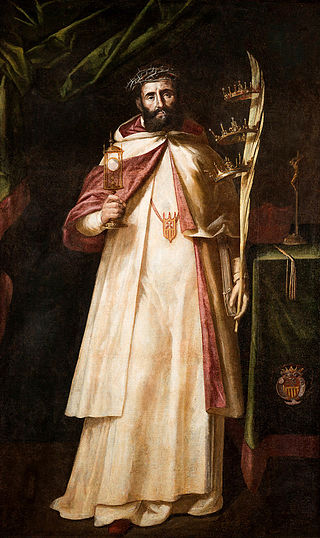
Raymond Nonnatus, O. de M., is a saint from Catalonia in Spain. His nickname refers to his birth by Caesarean section, his mother having died while giving birth to him.

John of Matha, OSsT (1160–1213) was a French Catholic priest and cofounder of the Order of the Most Holy Trinity, initially dedicated to ransoming Christians who had been captured by marauders from North Africa.
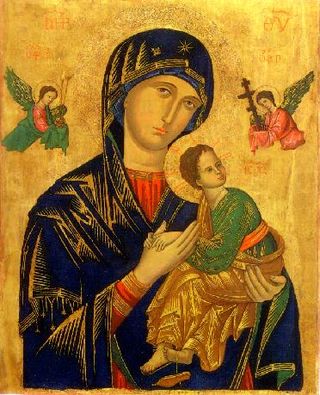
A patronage of the Blessed Virgin Mary is a form of spiritual protection attributed to Mary, mother of Jesus, in favor of some occupations, activities, religious orders, congregations, dioceses, and geographic locations.

The Feast of Our Lady of Ransom/Our Lady of Vallarpadam is a Roman Catholic liturgical Marian feast. In the General Roman Calendar of 1960, it was celebrated on 24 September, commemorating the foundation of the Mercedarians. After Vatican II, the name for the Marian commemoration on September 24 was changed to "Our Lady of Mercy".
Mary de Cervellione was a Catalan superior of the Second order of Mercedarians. She is a Catholic saint; her veneration, which began immediately after her death, was approved by Pope Innocent XII in 1692.

The Shrine of Our Lady of Bonaria also known as Our Lady of Fair Winds is a Marian title associated with the Blessed Virgin Mary as Star of the Sea and patron of sailboats. In addition, it is first associated with a Roman Catholic shrine to the Blessed Virgin Mary located in Cagliari, Sardinia (Italy).

The Virgin of Mercy is a subject in Christian art, showing a group of people sheltering for protection under the outspread cloak, or pallium, of the Virgin Mary. It was especially popular in Italy from the 13th to 16th centuries, often as a specialised form of votive portrait; it is also found in other countries and later art, especially Spain and Latin America.

The Scapular of Our Lady of Mercy is a Roman Catholic devotional scapular that traces its roots to the Order of the Blessed Virgin Mary of Mercy also known as Our Lady of Ransom which was founded by St. Peter Nolasco in the city of Barcelona, at that time in the Kingdom of Aragon, for the redemption of Christian captives.
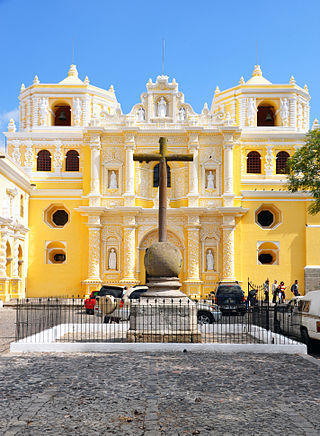
The Church and Convent of La Merced is a Catholic church located in the city of Antigua Guatemala in Guatemala. The architect Juan de Dios Estrada was in charge of its construction from 1749. The church was inaugurated in 1767.

Joan Gilabert Jofré (1364–1417), also known as Padre Jofré or Pare Jofré, was a member of the Christian religious Order of Mercy and the founder of what is claimed to be the first psychiatric care institution in Europe, in Valencia, Crown of Aragon, in medieval Spain.

The Basilica and Priory of Nuestra Señora de la Merced is a Roman Catholic church located in Lima, Peru. It was designed in the Baroque style known as Churrigueresque. The church was built under the supervision of Friar Miguel de Orenes in 1535. The Blessed Virgin Mary of Mercy, the patroness of the Peruvian Armed Forces, is venerated in the Basilica. The Mercedarians, who evangelized the region, helped to develop Lima by building many of the churches preserved today.

Santa Maria della Mercede e Sant'Alfonso Maria de' Liguori is a Roman Catholic church located in via San Sebastiano #1 in the historic center of Naples, Italy. It rises on the South-Eastern corner of the intersection of Via San Sebastiano - Via Santa Maria di Constantinopoli, and the Vico San Pietro da Maiella and the outlet of the Via Port'Alba, a narrow alley starting at the medieval gate of Port'Alba. The Vico San Pietro da Maiella feeds into the southernmost end of Via dei Tribunali, corner with via San Sebastiano, and on the Vico, neighboring to the east and behind the church, stands the Conservatory of San Pietro a Majella.
The Discalced Mercedarians are members of a mendicant order, which is a reform branch which developed in the 17th century of the Mercedarian Order, founded in the 12th century primarily to assist Christians who had been taken prisoner by Muslim armies or pirates. They use the postnominal initials O.M.D.
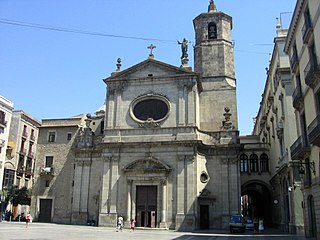
The Basilica of Our Lady of Mercy is a Baroque-style basilica in Barcelona, Catalonia. Our Lady of Mercy has been the patron saint of the city of Barcelona since 1687.
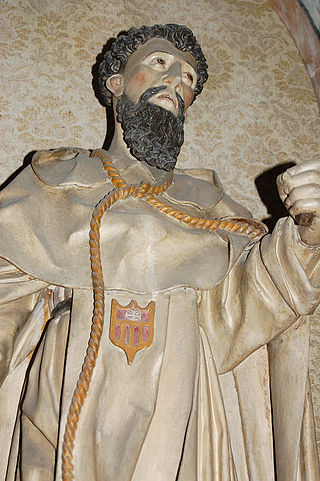
Pedro Armengol, born Pedro Armengol Rocafort, was a Spanish Roman Catholic who was of noble stock and a thief during his adolescence. He became a professed member of the Mercedarians after he experienced a sudden conversion and devoted himself to liberating captive Christians from the Moors. Armengol is best known for being hanged while a captive of the Moors but survived.

The Diocesan Shrine and Parish of Our Lady of Mercy is a Roman Catholic church under the Diocese of Novaliches in the Philippines. It is the oldest parish in the diocese, established in 1856 by the Augustinian missionaries from Spain.

The Basilica of La Merced, also known as Convent of La Merced, is a minor basilica located in the city of Cusco, Peru. It is located 100 meters southwest of the Plaza de Armas in front of the Plazoleta Espinar. It belongs to the Order of the Blessed Virgin Mary of Mercy and has, annexes, both the convent and the premises of La Merced College. The church has a three-nave basilica plan covered with brick vaults and dome on the crossing, with Baroque altars on its lateral naves and Neoclassical style on the main altar. It also has a tower with Baroque bell tower topped with a semicircular dome. Highlights its portal-side reredos and the Renaissance portal of the muro de pies, the choir stalls, its colonial paintings and polychrome wood carvings. Inside rest the remains of Diego de Almagro, Diego de Almagro II and Gonzalo Pizarro.

Nuestra Señora de la Merced Parish, is a Roman Catholic church located in Bahay Pare, Candaba, Pampanga in the Philippines. The parish church is under the Roman Catholic Archdiocese of San Fernando, Pampanga and is the home of the Nuestra Señora de la Merced de Pampanga, Emperatriz na Marilag sa Katagalugan ng Pampanga, which is the oldest and original image of the title. Devotees flock to the parish to ask Mary to intercede for their spiritual, mental, and physical health, for their families and studies, and for the increase of vocations to the priesthood and consecrated life. The parish covers most of the barangays of the Tagalog region under the patronage of Nuestra Señora dela Merced. The image is well known for her Dalit as She visits different places. The parish also holds first class relics of Mercedarian Saints, St. Peter Nolasco, St. Raymond of Penyafort, St. Serapion of Algiers, St. Raymond Nonnatus and St. Pedro Armengol.

























